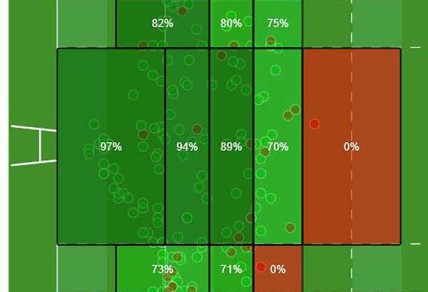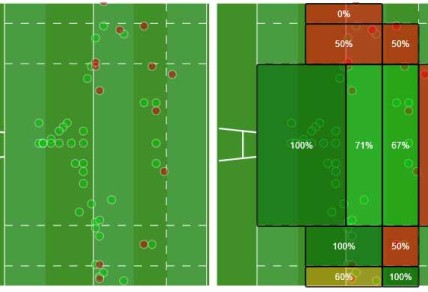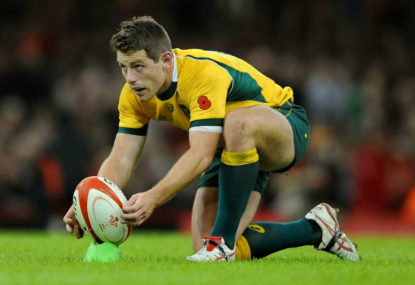The reaction to the Wallabies’ 39-28 loss to England in Brisbane was interesting.
In whichever outlet you’d care to look – and including these forums here – for every comment or tweet or forum post espousing the need for calm, and the value in not over-reacting, there were another two or three calling for immediate change. And that change generally ranged from a few tweaks to the starting props, to mass change – anywhere up to nine and ten changes to the matchday 23.
In more than a few cases, babies and bathwater were flying all over the place.
At least one change will be required, with David Pocock ruled out with a fractured eye socket. Rob Simmons’ lower back injury is a concern, too, and the lineout degradation after he was forced off was evident.
There may or may not be other changes, and we’ll know more as the week goes on. Will there be ten? I would highly doubt it. That would be more than a bit of an over-reaction, considering for all the Wallabies did wrong – and there was plenty – they still commanded upwards of two-thirds of both territory and possession.
A few tweaks here and there is probably warranted, but so would allowing the side who played in Brisbane the chance to redeem themselves in Melbourne this Saturday night. And having sat back and observed things for a few days, these same three aspects that stood out on Saturday night remain the obvious avenues for improvement days later.
Scrum
Much of the debate around the scrummaging issues were as much around English tighthead Dan Cole’s trickery as it was about Scott Sio’s inability to adjust to said trickery. There was little doubt that Sio was schooled in the dark arts by one of the best tightheads in the world, just as there was no doubt Cole enjoyed great success with his tactic of finding an angle and forcing Sio to ground by rolling his outside shoulder downward.
The legality of such a tactic is open for interpretation, and Romain Poite obviously saw no such issue. And that reminded me of Dan Palmer’s words late last year, when I got my own education in the dark arts from the former Waratahs and Brumbies prop during the opening weeks of the Rugby World Cup.
“I might be over-simplifying it, but in a way, I think the French have it right,” Palmer said at the time. “They will not look at technical things too much, and they will just reward dominance. So if you’re dominant, it’s probably going to go in your favour. You might be dominant for slightly illegal reasons, but who cares, that’s the art, and you’ve got to get better at that.”
I swapped texts with ‘Palms’ on Sunday afternoon, and he reiterated this belief, for what it’s worth, telling me he had no real issue with what Cole was doing. Sio, unfortunately, just wasn’t able to cope with the pressure.
The question then becomes one of whether Sio can turn it around within a week, or whether James Slipper should start. Whichever way Cheika goes, the Wallabies no.1 will be under enormous and immediate pressure. Cole will almost certainly be trying the same tactic, and it will be interesting to see if Craig Joubert allows the same concessions in Melbourne that Poite did in Brisbane.
And that’s before we even consider if the Melbourne turf will allow scrums to be completed in the first place.
Discipline
Straight from the notepad of Captain Obvious, the Wallabies’ discipline – or lack thereof – was a massive issue throughout the match, and essentially allowed England into the game.
Owen Farrell kicked five from six penalties – and both conversion attempts – between the 21st and 57th minutes, swinging the momentum of the match completely, and converting a ten-point deficit in a 14-point lead in the crucial period either side of halftime.
The Wallabies did well to score only a minute or so after Farrell’s 57th minute penalty, and while a man down, but they were firmly in catch-up mode by then.
To have conceded nine penalties to two by the break was one thing, but the ill-discipline continued after the break, suggesting the message either wasn’t delivered, or worse, it wasn’t heard.
But it should’ve been part of the build-up to start with. Owen Farrell is an 80 per cent kicker over his Test career, but the middle corridor of the field as far back as the 10m line is his bread-and-butter. The excellent website www.goalkickers.co.za shows that his success rate in this part of the field averages out around 93 per cent.

This must be addressed this week. Pure and simple.
Midfield clarity
I wouldn’t be disappointed if the same backline was named again for Melbourne, but I can also see the benefit of Christian Lealiifano coming into inside centre. News that Matt Toomua flew with the team to Melbourne adds an interesting twist, too.
But whatever combination Cheika goes with, there needs to be some clarity around who is running in the centre channels and when. There were times during the second half when it appeared Samu Kerevi, Israel Folau, and Tevita Kuridrani were all trying to operate in the same patch of turf, and while that in itself isn’t so much of an issue, it becomes an issue when they’re starting to compete with each other for the ball.
So I actually wonder, with two powerful runners in Kerevi and Kuridrani, if Folau should perhaps learn to pick his moments to chime into the backline a bit better. With those two players in the centre, Folau doesn’t really need to used as an option as often as he is with the Waratahs.
If the main strike runner is always there, then he becomes easier to pick off. It might actually be the case that Folau could increase his threat level by appearing in the backline less; ‘less is more’, if you like. To my eyes, it looked as though Kerevi looked a bit rushed at times in the presence of Folau, as if he was under pressure to get the ball to Folau regardless of what opportunities he had himself.
It might’ve been nerves on debut, but there might be more to it, too. At times, I thought Folau was overplayed as an option.
Of course, if Lealiifano – or Toomua – starts at 12, then that will require a re-jig of alignments, and that might provide the necessary clarification. Either way, I hope the Wallabies aren’t just dropping back into ‘JGITF’ mode.
And one more thing…
Plenty of discussion over the weekend around Bernard Foley having an ‘off night’ with his goal kicking, but a closer look at his 2016 form in shows that that might not necessarily be the case.

The images above are also from www.goalkickers.co.za. The one on the left shows Foley’s Super Rugby kicks in 2016, where he’d kicked 38 from 51 (74.5%), and the left is what the site calls their ‘heat map’, the success rate from the various parts of the field.
What it clearly shows is that Foley has a real issue with kicks outside the right-hand 15-metre ‘tram track’ line. That’s where his two missed conversions came from – both of Michael Hooper’s tries. In fact, these images show that Foley has an issue to the pretty well anywhere to the right of the posts.
He hit the post after Folau’s try, and converted Kuridrani’s. Both of those kicks were to the left of the post, where he enjoys a much better strike rate, and which is generally noted as the easier side for right-footers.
There’s no doubting Foley had a sub-par night overall off the tee. But there’s plenty of doubt about it being an anomaly. The evidence suggests converting both of Hooper’s tries would’ve been the anomaly. Either way, it’s something that needs improvement.































































































